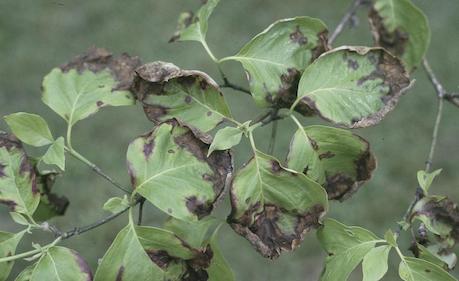Anthracnose is Coming — Be Ready
by Elizabeth Cornell Fake, Fairfax Master Gardener

Anthracnose on dogwood
As we celebrate spring in Virginia and enjoy all of the flowering trees, shrubs and plants, there is a sinister force at work that can destroy our gardens starting as soon as May. Anthracnose, a common fungal disease, is just lurking around the corner and waiting to strike. Anthracnose is a generic disease name for 200 different species of the fungi, Colletotrichum or Gleosporiam, which can affect a wide variety of trees, plants, flowers, vegetables, turfgrass and crops. Other common names include brown blight, citrus dieback citrus, stem canker, fruit rot, tear stain and leaf, shoot, or twig blight.
Anthracnose overwinters in soil and crop residues from the previous season and produces spores in tiny fruiting bodies called acervuli that invade your garden through many ways including spring rain, wind, insects and infected garden tools. Given the warm, moist conditions of spring and summer in Virginia (75 to 85 F), the probability of anthracnose can be as high as 75 percent.
Symptoms
Symptoms of anthracnose infestation vary depending on the host plant since it is host specific. However, it is easily recognizable given some common similarities:
- Dark water-soaked spots called lesions on leaves, stems, flowers or fruits;
- light on shoots and branches;
- Defoliation, shoot dieback;
- in the case of crops, significantly reduced yield.
Be sure to take advantage of the FCMGA local plant clinics for a positive identification of anthracnose. Bring a generous sample (12 inch piece) including stem and leaves, to the plant clinic. The clinic staff will help you fill out a form to send the item to the Diagnostic Lab for proper identification and diagnosis.
Affected Plants
Trees are particularly susceptible to anthracnose. In Virginia, the American Dogwood (Cornus florida) has been decimated by the virulent fungus Discula destructive, which arrived in this country from the Pacific Rim in the late 1970s and was finally identified in Virginia in 1991. This lethal disease has been distressing to Virginians as the American Dogwood is both the state tree and state flower. Sycamore trees (Plantus occidentalis) are also particularly vulnerable to a specific variant of anthracnose that doesn’t affect other trees. Other varieties of the fungi attack white oak, elm and maple trees.

Anthracnose on peony
The ever popular varieties of Dahlia that thrive in a moist environment suffer from anthracnose displaying dark spots on leaves and stems with eventual wilting and severe blight. Disease affected Hydrangeas also display dark round spots along with Chrysanthemums, which have the same dark spots and suffer leaf drop. Not to be left out, Impatiens also are a particular target of anthracnose and have dark spots that eventually result in complete defoliation.
Anthracnose affects numerous fruits including strawberries, grapes and other soft fruits. The disease causes dark, sunken lesions on the leaves, stems, flowers and the fruit.
Among all of the diseases that can affect tomatoes, anthracnose is there to take its toll as well. It also affects cucurbits, primarily peppers, and can be identified by the same dark lesions found on other plants. If you see large patches of large brown patches on the lawn, it could be anthracnose, especially if the lawn turf is fescue or bent grass.
Prevention
As anthracnose evolves from overwintered plant debris, practicing fall and winter garden cleanup and good garden hygiene can be a major factor in its prevention. If discovered, remove and destroy any residual infected tree and plant parts. Do not compost infected leaves, stems or fruit. Choose disease resistant variants of seeds and trees. Disease resistant American Dogwood variants include ‘Appalachian Spring,’ ‘Welch’s Bay Beauty,’ ‘Cherokee Chief’ and ‘Cherokee Brave.’ Install new garden plants in well-drained soil and nourish with compost to help resist disease. Use a drip irrigation system to disperse water slowly and evenly and to conserve water. Avoid overhead watering. Keep gardening tools clean using a solution of one part bleach to four parts water. As a final deterrent, plan to rotate annuals and vegetables to a new location every two to three years.
Treatment
Be aware of insects and mites that can spread anthracnose spores and keep ahead of them. Insecticidal soap and neem oil are organic fungicides and are effective in killing larvae and adult stages of insects and can be used to prevent fungal attacks on plants. Both products are available in local gardening centers. Be sure to follow the instructions on the label.
Although most anthracnose primarily disfigures its host without inflicting other harm, there are some instances where it will kill the plant or tree without chemical treatment. As many chemical products are toxic to humans, animals and other plants, it is wise to consult a professional for advice and to develop the best strategy going forward.
Anthracnose is a potent force for summer. Our best defense is to be prepared!
- References
- Fact Sheet: Anthracnose Disease of Ornamental Plants: A Pictorial, Stephen Brown, University of Florida, IFAS Extension Lee County
- Anthracnose — A Fungal Disease of Shade Trees, Mary Ann Hansen, Elizabeth Bush and Lina Rodriguez Salamansa, Virginia Cooperative Extension, Fact Sheet 450-604 (SPES-555P)
- Dogwood Anthracnose, University of Maryland Extension, Home and Garden Information Center